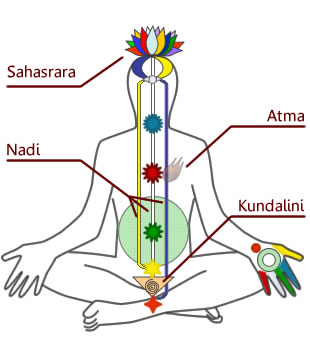
In Hinduism, Kundalini is a form of divine feminine energy believed to be located at the base of the spine, in the muladhara. It is an important concept in Śhaiva Tantra, where it is believed to be a force or power associated with the divine feminine or the formless aspect of the Goddess. This energy in the body, when cultivated and awakened through tantric practice, is believed to lead to spiritual liberation. Kuṇḍalinī is associated with Parvati or Adi Parashakti, the supreme being in Shaktism; and with the goddesses Bhairavi and Kubjika. The term, along with practices associated with it, was adopted into Hatha yoga in the 9th century. It has since then been adopted into other forms of Hinduism as well as modern spirituality and New age thought.

Kundalini yoga derives from kundalini, defined in tantra as energy that lies within the body, frequently at the navel or the base of the spine. In normative tantric systems, kundalini is considered to be dormant until it is activated and channeled upward through the central channel in a process of spiritual perfection. Other schools, such as Kashmir Shaivism, teach that there are multiple kundalini energies in different parts of the body which are active and do not require awakening. Kundalini is believed by adherents to be power associated with the divine feminine, Shakti. Kundalini yoga as a school of yoga is influenced by Shaktism and Tantra schools of Hinduism. It derives its name through a focus on awakening kundalini energy through regular practice of mantra, tantra, yantra, yoga, laya, haṭha, meditation, or even spontaneously (sahaja).
In yoga, Ayurveda, and Indian martial arts, prana permeates reality on all levels including inanimate objects. In Hindu literature, prāṇa is sometimes described as originating from the Sun and connecting the elements.
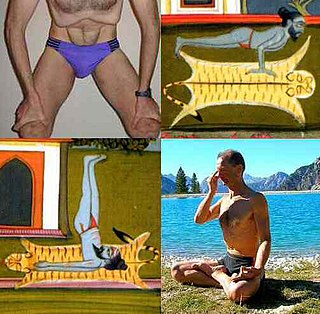
Hatha yoga is a branch of yoga that uses physical techniques to try to preserve and channel vital force or energy. The Sanskrit word हठ haṭha literally means "force", alluding to a system of physical techniques. Some hatha yoga style techniques can be traced back at least to the 1st-century CE, in texts such as the Hindu Sanskrit epics and Buddhism's Pali canon. The oldest dated text so far found to describe hatha yoga, the 11th-century Amṛtasiddhi, comes from a tantric Buddhist milieu. The oldest texts to use the terminology of hatha are also Vajrayana Buddhist. Hindu hatha yoga texts appear from the 11th century onward.
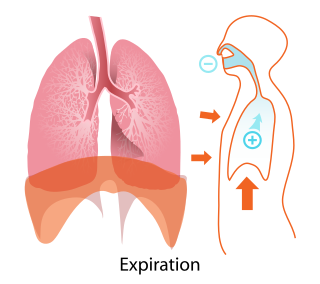
Exhalation is the flow of the breath out of an organism. In animals, it is the movement of air from the lungs out of the airways, to the external environment during breathing. This happens due to elastic properties of the lungs, as well as the internal intercostal muscles which lower the rib cage and decrease thoracic volume. As the thoracic diaphragm relaxes during exhalation it causes the tissue it has depressed to rise superiorly and put pressure on the lungs to expel the air. During forced exhalation, as when blowing out a candle, expiratory muscles including the abdominal muscles and internal intercostal muscles generate abdominal and thoracic pressure, which forces air out of the lungs.
Soham or Sohum is a Hindu mantra, meaning "I am He/She/That" in Sanskrit.

Pranayama is the yogic practice of focusing on breath. In yoga, breath is associated with prana, thus, pranayama is a means to elevate the prana-shakti, or life energies. Pranayama is described in Hindu texts such as the Bhagavad Gita and the Yoga Sutras of Patanjali. Later in Hatha yoga texts, it meant the complete suspension of breathing. The pranayama practices in modern yoga as exercise are unlike those of the Hatha yoga tradition.

Satyananda Saraswati, was a Sanyasi, yoga teacher and guru in both his native India and the West. He was a student of Sivananda Saraswati, the founder of the Divine Life Society, and founded the Bihar School of Yoga in 1964. He wrote over 80 books, including the popular 1969 manual Asana Pranayama Mudra Bandha.
Bindu is a Sanskrit word meaning "point", "drop" or "dot".
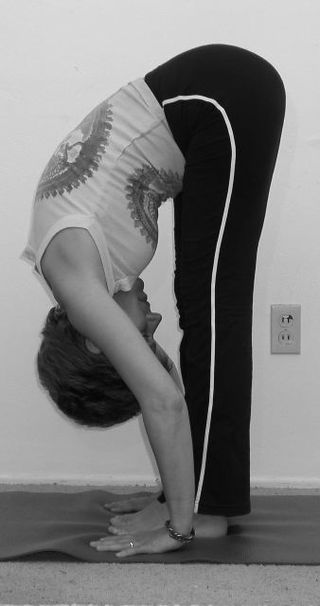
Uttanasana or Standing Forward Bend, with variants such as Padahastasana where the toes are grasped, is a standing forward bending asana in modern yoga as exercise.
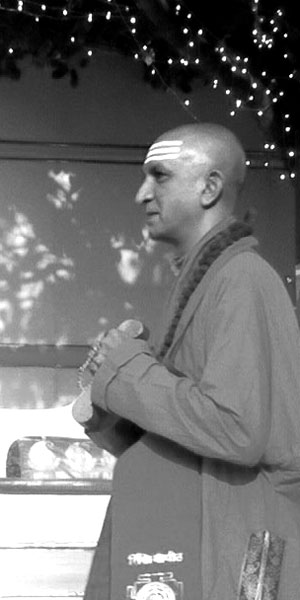
Swami Niranjanananda Saraswati is the successor of Satyananda Saraswati, founder of Satyananda Yoga, who passed on the worldwide coordination of Satyananda Yoga to Niranjanananda in 1988.

Kumbhaka is the retention of the breath in the yoga practice of pranayama. It has two types, accompanied whether after inhalation or after exhalation, and, the ultimate aim, unaccompanied. That state is kevala kumbhaka, the complete suspension of the breath for as long as the practitioner wishes.

Swami Janakananda Saraswati is a tantric yoga and meditation teacher and a writer, who has had a significant influence in the dissemination of yoga and meditation in Scandinavia and Northern Europe. He is the oldest active sannyasin disciple of Satyananda Saraswati in Europe.
Ujjayi is a breathing technique employed in a variety of yoga practices. In relation to yoga, it is sometimes called "the ocean breath." Unlike some other forms of pranayama, the ujjayi breath is typically done in association with asana practice in some styles of yoga as exercise, such as Ashtanga Vinyasa Yoga.
Anuloma Pranayama is one of several Pranayama or breath exercises used in the practice of Hatha yoga. Anu roughly translates as with and Loma means hair implying "with the grain" or "natural". It is the opposite of Viloma Prāṇāyāma which means against the grain.

Neti is an important part of Shatkarma, the Hindu yogic system of body cleansing techniques. It can have universal application, irrespective of their religion. It is intended mainly to clean the air passageways in the head. Both the Hatha Yoga Pradipika and other sources usually attribute to Neti many beneficial effects that range from profound physiological ones on the body, mind and personality to even clairvoyance. The two main variants are jala neti (जलनेति) using water and the more advanced sutra neti (सूत्रनेति) using string.
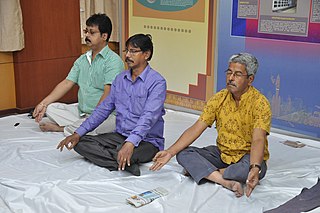
Kapalbhati is an important shatkarma, a purification in hatha yoga. The word kapalabhati is made up of two Sanskrit words: kapāla meaning "skull", and bhāti meaning "shining, illuminating". It is intended mainly for cleaning the sinuses but according to the Gheranda Samhita has magical curative effects. There are three forms of Kapalabhati:

Natarajasana, Lord of the Dance Pose or Dancer Pose is a standing, balancing, back-bending asana in modern yoga as exercise. It is derived from a pose in the classical Indian dance form Bharatnatyam, which is depicted in temple statues in the Nataraja Temple, Chidambaram. Nataraja, the "Dancing King", is in turn an aspect of the Hindu God Shiva, depicted in bronze statues from the Chola dynasty. The asana was most likely introduced into modern yoga by Krishnamacharya in the early 20th century, and taken up by his pupils, such as B. K. S. Iyengar, who made the pose his signature. Natarajasana is among the yoga poses often used in advertising, denoting desirable qualities such as flexibility and grace.
Vajroli mudra, the Vajroli Seal, is a practice in Hatha yoga which requires the yogin to preserve his semen, either by learning not to release it, or if released by drawing it up through his urethra from the vagina of "a woman devoted to the practice of yoga".













